Porsche Boxster
| Porsche Boxster | |
|---|---|
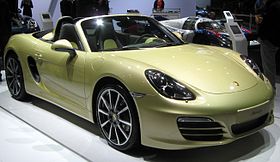 | |
| Overview | |
| Manufacturer | Porsche |
| Production | 1996–Present |
| Assembly | Stuttgart (Zuffenhausen), Germany (1996-) Uusikaupunki, Finland (Valmet, 1997-2011)[1] Osnabrück, Germany (2012-) |
| Body and chassis | |
| Class | Sports car |
| Body style | 2-door roadster |
| Layout | RMR layout |
| Related | Porsche Cayman Ruf RK Spyder Ruf 3400S |
The Porsche Boxster is a mid-engined two-seater roadster built by Porsche. The Boxster is Porsche's first road vehicle to be originally designed as a roadster since the 550 Spyder.
The first-generation Boxster (the 986) was introduced in late 1996; it was powered by a 2.5 litre flat six-cylinderengine. The design was heavily influenced by the 1992 Boxster Concept. In 2000, the base model was upgraded to a 2.7 litre engine and the new Boxster S variant was introduced with a 3.2 litre engine. In 2003, styling and engine output was upgraded on both variants.
In 2005, Porsche unveiled the second generation of Boxster: the type 987. The 987 is more powerful than its predecessor and featured styling inspired by the Carrera GT. Engine output increased in 2007, when both Boxster models received the engines from their corresponding Porsche Cayman variants. In 2009, the Boxster models received several new cosmetic and mechanical upgrades, further increasing engine output and performance. The third generation Boxster (type 981) was launched at the 2012 Geneva Motor Show.
Production of the 986 began at the former Porsche 928 facility in Stuttgart, Germany in 1996. Valmet Automotivealso manufactured Boxsters under contract to Porsche at a facility in Uusikaupunki, Finland. The Boxster was Porsche's biggest volume seller from its introduction in 1996 until the company introduced the Cayenne sport utility vehicle in 2003. As of September 2012, additional production of the 981 started at the former Karmann-factory inOsnabrück.[2]
The Boxster's name is derived from the word "boxer", referring to the vehicle's horizontally opposed or "boxer" engine, and the word "roadster", referring to the vehicle's two-seat capacity and convertible top.
986
| Boxster (986) | |
|---|---|
 | |
| Overview | |
| Manufacturer | Porsche |
| Production | 1996–2004 |
| Powertrain | |
| Engine | 2.5 L flat-6 (1996–2000) 2.7 L flat-6 (2000–2004) 3.2 L flat-6 (2000–2004) |
| Transmission | 5-speed automatic 5-speed manual 6-speed manual |
| Dimensions | |
| Wheelbase | 1997–2002: 95.2 in (2,418 mm) 2003–04: 95.1 in (2,416 mm) |
| Length | 1997–2002: 171.0 in (4,343 mm) 2003–04: 170.1 in (4,321 mm) |
| Width | 70.1 in (1,781 mm) |
| Height | 50.8 in (1,290 mm) |
| Chronology | |
| Predecessor | Porsche 968 |
| Successor | Porsche Boxster 987 |
Harm Lagaay's design, inspired by the 356 Cabriolet, Speedster, and 550 Spyder, stimulated a commercial turnaround for Porsche. Through consultation with Toyota, Porsche began widely sharing parts among models and slashed costs.[3] Many believe the introduction of the Boxster helped save Porsche from acquisition.
The Boxster was released ahead of its big brother, the 996. The 986 Boxster had the same bonnet, front wings, headlights, interior and engine architecture as the 996.
All 986 and 987 Boxsters use the M96, a water-cooled, horizontally opposed ("flat"), six-cylinder engine. It was Porsche's first water-cooled non-front engine. In the Boxster, it is placed mid-engine, while in the 911, rear-engine. The mid-engine layout provides a low center of gravity, near-perfect weight distribution, and neutral handling. Early engines had a small number of failures, due to cracked or slipped cylinder liners, which were resolved by a minor redesign in 2000.
The model received a minor facelift in 2003. The plastic rear window was replaced by a smaller glass window. The interior received a glove compartment, new electro-mechanical hood and trunk release mechanism (with an electronic emergency release in the fuse box panel) and an updated steering wheel. Porsche installed a reworked exhaust pipe and air intake. In addition, the front headlight's amber indicators were replaced with clear indicators. The rear light cluster was also changed with translucent grey turn signals replacing the amber ones. The side marker lights on the front wings were changed as well from amber to clear, except on American market cars where they remained amber. The bumpers were also changed slightly for a more defined, chiselled appearance, and new wheel designs were made available.
Boxster 986 model history
| Year | Engine | HP | Transmission | 0–100 km/h (0–60 mph) | Top speed |
|---|---|---|---|---|---|
| 1996 | 2.5L | 150 kW (204 PS; 201 hp) | Manual | 6.9 seconds (6.7 sec) | 240 km/h (149 mph) |
| 2.5L | 150 kW (204 PS; 201 hp) | TipTronic | 7.6 seconds (7.4 sec) | 235 km/h (146 mph) | |
| 2000 | 2.7L | 162 kW (220 PS; 217 hp) | Manual | 6.6 seconds (6.5 sec) | 250 km/h (155 mph) |
| 2.7L | 162 kW (220 PS; 217 hp) | TipTronic | 7.4 seconds (7.2 sec) | 245 km/h (152 mph) | |
| 3.2L S | 185 kW (253 PS; 250 hp) | Manual | 5.9 seconds (5.6 sec) | 260 km/h (162 mph) | |
| 3.2L S | 185 kW (253 PS; 250 hp) | TipTronic | 6.5 seconds (6.2 sec) | 255 km/h (158 mph) | |
| 2003 | 2.7L | 168 kW (229 PS; 225 hp) | Manual | 6.2 seconds | 253 km/h (157 mph) |
| 2.7L | 168 kW (229 PS; 225 hp) | TipTronic S | 7.0 seconds | 248 km/h (154 mph) | |
| 3.2L S | 191 kW (261 PS; 258 hp) | Manual | 5.4 seconds | 264 km/h (164 mph) | |
| 3.2L S | 191 kW (261 PS; 258 hp) | Tiptronic S | 6.1 seconds | 258 km/h (160 mph) | |
| 2004 550 | 3.2L S | 196 kW (264 PS; 266 hp) | Manual | 5.7 seconds | 266 km/h (165 mph) |
550 Spyder 50th Anniversary Edition
In 2004 the 550 Spyder 50th Anniversary Edition was released, with a production run of just 1953 cars. These were all painted GT Silver Metallic, the same color as the car-show version of the Carrera GT supercar, and had unique cocoa-brown full-leather interior as standard with grey natural leather as a no-cost option. Each car also had special interior paintwork, a high-end BOSE sound system, two-tone grey and silver 18" Carrera wheels (unpainted as another zero-cost option), 5 mm (0.2 in) wheel spacers, the Boxster S sport exhaust, the M030 option sports suspension, and a plate on the center console piece commonly known as the "batwing" showing the production number. Only on the American market cars were the rear turn signals red rather than clear.
987
| Boxster (987) | |
|---|---|
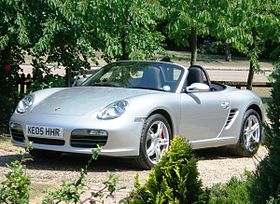 | |
| Overview | |
| Manufacturer | Porsche |
| Production | 2004–2012 |
| Assembly | Finland |
| Body and chassis | |
| Layout | MR |
| Related | Porsche Cayman |
| Powertrain | |
| Engine | 2.7 L flat-6 (2005–2008) 2.9 L flat-6 (2009–2012) 3.2 L flat-6 (2005–2006) 3.4 L flat-6 (2007–2012) |
| Transmission | 5-speed automatic 5-speed manual 6-speed manual 7-speed PDK |
| Dimensions | |
| Wheelbase | 95.1 in (2,416 mm)[4] |
| Length | 2005–08: 171.6 in (4,359 mm)[4] 2009– : 172.0 in (4,369 mm) |
| Width | 2005–08: 70.9 in (1,801 mm)[4] 2009– : 71.5 in (1,816 mm) |
| Height | 51.0 in (1,295 mm)[4] |
| Curb weight | 3,130 lb (1,420 kg)[4] |
| Chronology | |
| Predecessor | 986 |
| Successor | 981 |
The second generation of the Boxster (internally known as the 987) made its debut at the 2004 Paris Motor Showalongside the new 911 (997). The car became available in 2005.
In appearance the car remains very similar to the previous generation. The most obvious styling change is to the headlights, which now have a profile similar to those of the Carrera GT, Porsche's mid-engined supercar. The intake vents on the sides of the Boxster are now larger, with more pronounced horizontal slats and are coloured metallic silver, irrespective of the paint colour on the rest of the car. The wheel arches have been enlarged to allow wheels up to 19 inches in diameter, a first for the Boxster series. The most significant updates from the 986 series are in the interior, with a more prominent circular theme evident in the instrument cluster and cooling vents. Porsche claims that the 987 Boxster shares only 20% of its components with its predecessor.[citation needed] The base engine is a 2.7 L 176 kW (240 hp) flat-6, with the Boxster S getting a 3.2 L 206 kW (280 hp) engine. The Cayman coupe is derived from the 987.
For 2007 the base Boxster received a revised engine featuring VarioCam Plus to provide a 5 hp (3.7 kW) boost (245 hp (183 kW) the same as the Cayman). The Boxster S engine was upgraded from 3.2L to 3.4L, resulting in the production of 15 hp (11 kW) more (295 hp (220 kW) the same as the Cayman S). These upgrades made the Boxster series and the Cayman series equivalent in terms of power.
Boxster 987 model history
-
- MY 2005
- 2.7L 176.5 kW (240 PS; 237 hp)
- 3.2L 206 kW (280 PS; 276 hp) Boxster S
- MY 2007
- 2.7L 180 kW (245 PS; 241 hp)
- 3.4L 217 kW (295 PS; 291 hp) Boxster S
987 Generation II
Porsche first revealed the face-lifted 2008 Boxster and Boxster S models at the Los Angeles International Auto Showin November 2008. Both models feature greater power due to an increase in engine displacement for the Boxster and the incorporation of Direct Fuel Injection (DFI) for the Boxster S. Both models are now available with Porsche's new 7-speed Porsche Doppelkupplungsgetriebe (PDK) dual clutch gearbox but come standard with a new 6-speedmanual gearbox. Displacement in the standard Boxster's flat-six engine increased from 2.7 to 2.9 liters, increasing power from 245 hp (183 kW) to 255 hp (190 kW). Use of DFI in the Boxster S raised the output of the 3.4 liter engine from 295 hp (220 kW) to 310 hp (230 kW). Cosmetic changes to the 2009 Boxster and Boxster S include new head and tail lights, larger front air intakes with incorporated day time running lights, and an altered lower rear end flanked by twin diffusers. The interior includes the redesigned Porsche Communication Management System as an option with a touchscreen interface to reduce button clutter.
MY 2009Boxster 987 Gen II model history
- 2.9L 188 kW (256 PS; 252 hp)
- 3.4L 228 kW (310 PS; 306 hp)
Limited editions
RS60 Spyder
In November 2007, Porsche announced a commemorative RS60 Spyder edition of the Boxster to celebrate Porsche's 1960 win in the 12 Hours of Sebring in Florida.[6] Only 1960 units in this series are to be produced worldwide, with approximately 800 slated for the U.S. with each model bearing a numbered production badge on the dash. The RS60 Spyder comes in only GT Silver Metallic while the standard interior is Carrera Red leather, with dark gray leather as an option. The RS60 comes standard with 19 inch SportDesign alloy wheels, Porsche's Active Suspension Management System, and a sports exhaust that boosts the engine output to 303 PS (223 kW; 299 hp). The base price for the RS60 Spyder is US$64,900.
Porsche Design Edition 2
Porsche also produced a limited Boxster S Porsche Design Edition 2 that debuted in October 2008 as 2009 model.[7] It featured freer-flowing exhaust, which raised power from 295 PS (217 kW; 291 hp) at 6250 rpm to 303 PS (223 kW; 299 hp) at an identical 6250 rpm. It came in a unified Carrara White paint scheme with matching white 19-inch wheels, a black and grey interior with white gauges, red taillights and light grey stripes along the entire body. 500 were made for the worldwide market, 32 shipped into the U.S. and 18 into Canada. The base price for the PDE2 Boxster was US$66,900.
Limited Edition
Porsche unveiled its 2008 Limited Edition Boxster and Boxster S models at a private gathering down the street from the 2007 New York Auto Show. Largely inspired by the 2007 911 GT3 RS, just 250 examples of each model would be produced in brilliant orange and priced at $49,900 (original MSRP $45,800) and $59,900 (original MSRP $55,700) respectively.
Clad in the striking RS-special orange paint of the 911 GT3-RS with glossy black painted mirrors, alloy wheels, front and side air inlets, and model designation. The SportDesign package adds visual appeal, and includes aggressive front splitters, a revised rear two-stage spoiler that extends automatically at speed, and an integrated rear diffuser that Porsche says reduces aerodynamic lift. A sports exhaust system with a dual chromed exhaust tip is included, and is claimed to add a few more horsepower. Inside, a numbered 'Limited Edition' plaque is found on the glove box door, while the seat inserts, 911 GT3-spec steering wheel, and handbrake lever all receive Alcantara trim, a suede-like material used on performance Porsches like the 911 GT3 and 911 GT3 RS. Orange roll-over hoops, door lever surrounds, shift knob, cup-holder cover trim and even the font on the gear shift pattern carrying bright orange that match the exterior color and offset the otherwise black interior. Only 250 each, Limited Edition Boxster and ‘S’ models hit showrooms on September 28, 2008. CNBC recently named the Limited Edition as one of its top 15 Most Desirable Porsches.
Clad in the striking RS-special orange paint of the 911 GT3-RS with glossy black painted mirrors, alloy wheels, front and side air inlets, and model designation. The SportDesign package adds visual appeal, and includes aggressive front splitters, a revised rear two-stage spoiler that extends automatically at speed, and an integrated rear diffuser that Porsche says reduces aerodynamic lift. A sports exhaust system with a dual chromed exhaust tip is included, and is claimed to add a few more horsepower. Inside, a numbered 'Limited Edition' plaque is found on the glove box door, while the seat inserts, 911 GT3-spec steering wheel, and handbrake lever all receive Alcantara trim, a suede-like material used on performance Porsches like the 911 GT3 and 911 GT3 RS. Orange roll-over hoops, door lever surrounds, shift knob, cup-holder cover trim and even the font on the gear shift pattern carrying bright orange that match the exterior color and offset the otherwise black interior. Only 250 each, Limited Edition Boxster and ‘S’ models hit showrooms on September 28, 2008. CNBC recently named the Limited Edition as one of its top 15 Most Desirable Porsches.
Boxster Spyder
On November 5, 2009, Porsche officially announced the creation of a new production Boxster which was officially unveiled at the 2009 Los Angeles Motor Show. Positioned above the Boxster S, the Boxster Spyder was the lightest Porsche on the market at the time, weighing 2,811 pounds (1,275 kg), a full 176 pounds (80 kg) lighter than a Boxster S. This was achieved through the elimination of the conventional soft top's operating mechanism, the radio/PCM unit, door handles, air conditioning, storage compartments, cupholders and large LED light modules on the front fascia, although some of these could be re-added to the car in the form of options. Weight savings was also gained using aluminum doors, an aluminum rear deck and the lightest 19-inch wheels in the Porsche pallet. The vehicle rides on a firmer suspension than the other Boxster models, and is almost one inch lower in order to have firmer handling. A manually operated canvas top, carbon fiber sports bucket seats and two signature humps running along the back of the vehicle provide characteristic design elements. It is powered by a six-cylinder boxer engine with 320 horsepower (239 kW; 324 PS) and 273 lb·ft (370 N·m) of torque, a 10 hp (7.5 kW) increase over the engine in the Boxster S and the same engine used in the related Cayman S, with manual transmission as standard and Porsche's PDK dual-clutch gearbox as an option. The vehicle was released worldwide in February 2010 as a 2011 model with a base price of US$61,200.[8]
981
| Boxster (981) | |
|---|---|
 | |
| Overview | |
| Manufacturer | Porsche |
| Production | 2012-Present |
| Powertrain | |
| Engine | 2.7 L flat-6 3.4 L flat-6 |
| Transmission | 7-speed PDK 6-speed manual |
| Dimensions | |
| Wheelbase | 2,475 mm (97.4 in) |
| Length | 4,374 mm (172.2 in) 4,404 mm (173.4 in) (GTS) |
| Width | 1,801 mm (70.9 in) |
| Height | 1,282 mm (50.5 in) 1,273 mm (50.1 in) (GTS) |
| Kerb weight | 1,310 kg (2,890 lb) (2.7 manual) 1,345 kg (2,965 lb) (GTS manual) |
| Chronology | |
| Predecessor | Boxster (987) |
The third generation Boxster was announced on 13 March 2012 at the Geneva Auto Show with sales starting early summer 2012. The new Boxster reflects the new design language from the 911 (991) and 918, and features new and revised engine and transmission specifications. Together with a new body, the type 981 Boxster features a new chassis; 40 per cent more torsionally rigid, the front track is 40mm wider, the rear 18mm wider and the wheelbase extended by 60mm, but with a small weight reduction of up to 35 kilograms (77 lb) compared to the previous type 987 Boxster.[9]
The standard Boxster is fitted with a new 2.7-litre flat-6 engines, and the Boxster S is fitted with the existing 3.4-litre engine but with revised performance. Both engines are equipped with a 6-speed manual gearbox and an optional 7-speed reworked PDK. Both manual and automatic models are available with several technical options including Porsche Torque Vectoring (PTV) and a Sport Chrono Package that includes active transmission mounts, and makes the PDK-equipped model even faster. Porsche claims that the new generation Boxster provides fuel savings of 15% over the outgoing model.
The range was expanded in March 2014 with the addition of the GTS derivative, with slightly altered front and rear bumpers and an additional 15bhp from the 3.4-litre engine.[10]
| Year | Engine | Power | Torque | Transmission (gears) | 0–100 km/h (60 mph) | Top speed | CO2 |
|---|---|---|---|---|---|---|---|
| 2012- | 2.7L (2706 cc)[11] | 195 kW (265 PS; 261 bhp) | 280 N·m (207 lb·ft) | Manual (6) | 5.8 seconds (5.5) | 264 km/h (164 mph) | 192g/km |
| 2012- | 2.7L (2706 cc) | 195 kW (265 PS; 261 bhp) | 280 N·m (207 lb·ft) | PDK (7) | 5.7 seconds (5.4) | 262 km/h (163 mph) | 180g/km |
| 2012- | 2.7L (2706 cc) Sport Chrono | 195 kW (265 PS; 261 bhp) | 280 N·m (207 lb·ft) | PDK (7) | 5.5 seconds (5.2) | 262 km/h (163 mph) | 180g/km |
| 2012- | 3.4L (3436 cc)[12] | 232 kW (315 PS; 311 bhp) | 360 N·m (266 lb·ft) | Manual (6) | 5.1 seconds (4.8) | 279 km/h (173 mph) | 206g/km |
| 2012- | 3.4L (3436 cc) | 232 kW (315 PS; 311 bhp) | 360 N·m (266 lb·ft) | PDK (7) | 5.0 seconds (4.7) | 277 km/h (172 mph) | 188g/km |
| 2012- | 3.4L (3436 cc) Sport Chrono | 232 kW (315 PS; 311 bhp) | 360 N·m (266 lb·ft) | PDK (7) | 4.8 seconds (4.5)[13] | 277 km/h (172 mph) | 188g/km |
| 2014- | 3.4L (3436 cc) GTS | 243 kW (330 PS; 326 bhp) | 370 N·m (273 lb·ft) | Manual (6) | 5.0 seconds[14] | 281 km/h (175 mph) | 211g/km |
| 2014- | 3.4L (3436 cc) GTS | 243 kW (330 PS; 326 bhp) | 370 N·m (273 lb·ft) | PDK (7) | 4.7 seconds | 279 km/h (173 mph) | 190g/km |
| 2015- | 3.8L (3800cc) Spyder | 276 kW (375 PS; 370 bhp) | 420 N·m (310 lb·ft) | Manual (6) | 4.5 seconds (4.3) | 290 km/h (180 mph) | 230g/km |
981 Boxster Spyder[
Porsche revealed the latest Spyder model in April 2015 at the New York Auto Show. The styling of the car is similar to the previous generation Spyder, continuing the twin hump rear deck and manually operated canvas top. It also shares some styling with the Cayman GT4, using the same front and rear fascia. The engine is also shared with the Cayman GT4, a 3.8l flat-6, making this the largest capacity and most powerful engine used in a Boxster with 276 kilowatts (370 bhp). It is also the lightest current Porsche, weighing 1,315 kilograms (2,899 lb). This was achieved through the use of aluminum doors and rear lid, the manually operated roof and unique light weight 20 inch wheels. The air conditioning and audio system are also removed, although can be added as no cost options. Braking is via larger brakes than used on the Boxster S, being 340mm front and 330mm rear units taken from the 911 Carrera S. The only gearbox available is a 6 speed manual. The Spyder has a base price of US$82,100
Racing
The Boxster has taken part in the Continental Tire Sports Car Challenge Street Tuner class.[15] A Boxster Spec racing series based on the early 1997-1999 2.5-liter models is organized by National Auto Sport Association (NASA).[16]
In the UK, Boxsters take part in the BRSCC Porsche Championship, in Spec or Production specification[17] and in the Porsche Club Championship.
Awards
The Boxster has received a number of international and regional awards:
- Car and Driver: One of the Ten Best list eleven times, from 1998 through 2003 and 2006 through 2010
- Automobile: Automobile of the Year once and All Stars Award nine times including 2010[18] and 2012[19]
- Motor: 1997 Performance Car of the Year
- Autocar: Best Roadster in the World
- Auto Express: 2012 Roadster of the Year[20]
- evo: magazine's recommended buy in the Sports Car category and has been since the model's introduction (986 & 987)
- Motorweek: 1997 Drivers Choice for Best Sports Car
- The Philadelphia Inquirer: Best Sports Car of the Decade
- Newsweek: One of the Best New Products of 1997
- BusinessWeek: One of the Best New Products of 1997
- Excellence: Boxster S (986s) was rated one of the top ten Porsches of all time
- American Marketing Association: Best New Product of 1997
- Automobile Journalists of Canada: 1997 Car of the Year and Best Design of 1997
- Scottish Car of the Year 2012 Best Drop Top
- South African Car of the Year 2013
- What Car?: Sports Car of the Year 2015
Mechanical issues and lawsuit
Some Boxster models manufactured between May 4, 2001 and February 21, 2005 have suffered catastrophic engine failure due to a fault with the intermediate shaft (IMS) bearing, which has resulted in a class action lawsuit against Porsche Cars North America (referred to as Eisen v. Porsche Cars North America).[21] A settlement was agreed in March 2013, subject to court approval. Other types of engine failure experienced in the Boxster including cracking of the cylinders (D-chunk issue), and problems with the early castings of the engine cases (case porosity issue) are not addressed by this suit. Additionally, the issues are not limited to the model years covered in the suit, or the Boxster, as the 911's share the same type of engine.

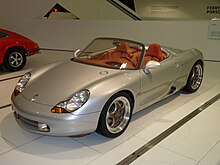



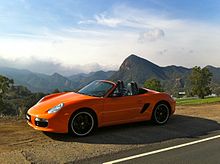

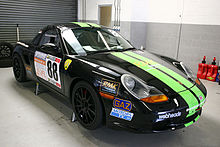
No comments:
Post a Comment